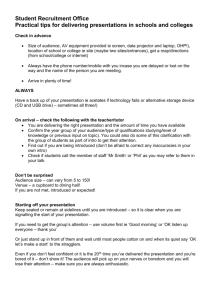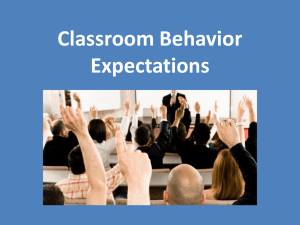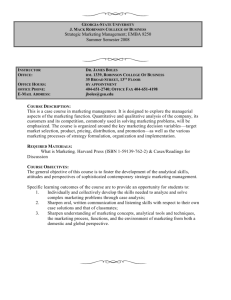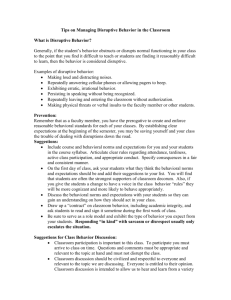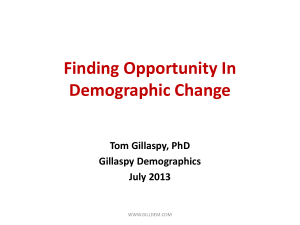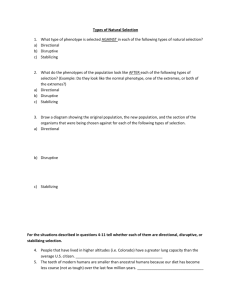Module V - Breakthrough - Stevens Institute of Technology
advertisement
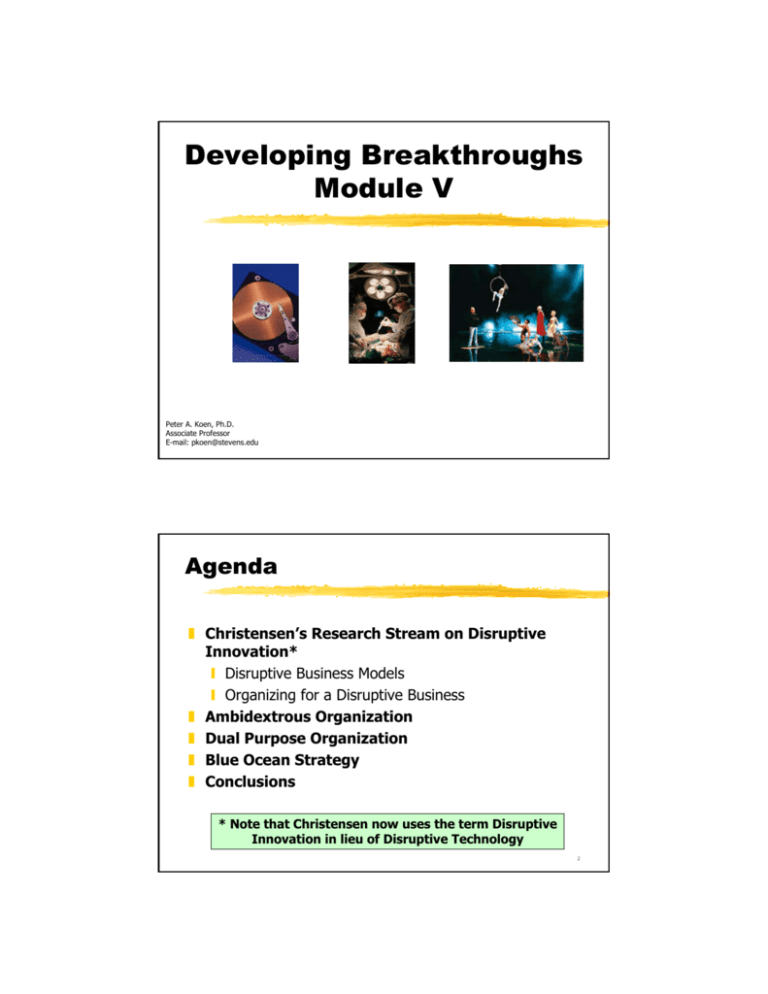
Developing Breakthroughs Module V Peter A. Koen, Ph.D. Associate Professor E-mail: pkoen@stevens.edu Agenda ] Christensen’s Research Stream on Disruptive Innovation* \ Disruptive Business Models \ Organizing for a Disruptive Business ] Ambidextrous Organization ] Dual Purpose Organization ] Blue Ocean Strategy ] Conclusions * Note that Christensen now uses the term Disruptive Innovation in lieu of Disruptive Technology 2 Disruptive Businesses A driver of business failures and a source of new growth opportunities Christensen, C. M., “The Innovator’s Dilemma: When New Technologies Cause Great Firms to Fail,” Harvard Business School Press, Boston, (1997). Christensen, C.M and Raynor, M.E., “The Innovator’s Solution: Creating and Sustaining Successful Growth,” Harvard Business School Press, Boston, (2003). 3 Disruptive Business Models ] Low End Disruption \ Example: Mini-Mills ] New Market Disruption \ Example: Angioplasty 4 Disruptive Business Models Low End Disruption: Mini-Mills 5 Disruptive Business Models What is a Disruptive Business? Up-Market Migration of Steel Minimills 25 -3 Shee 0% Gross 18 % Steel Quality in Marg rgin s Ma Gros el Ba Iron: Angle s Gros 12 % in Marg rs an 1980 s d Ro d 8% 4% r Reba Disruptive Businesses over time will improve and attack the sustaining business. s Gros 7% in Marg 1975 55% 22% el t Ste Ste tural Struc % of Steel Production 1985 1990 6 Disruptive Business Models New Market Disruption: Angioplasty CABG (Cardiac Arterial Bypass Graft Angioplasty 7 Disruptive Business Models What is a Disruptive Business? Up-Market Migration of Angioplasty 1200 Bypass Procedures (000s) 1000 Stents 800 600 400 200 Balloon Angioplasty 0 1985 1986 1987 1988 1989 1990 1991 1992 1993 1994 1995 1996 1997 1998 1999 8 Disruptive Business Models Sustaining Businesses ALWAYS reject Disruptive Business Models Why sustaining businesses don’t compete with new business model Initial Customer Niche is initially too small and takes focus away from mainstream customers Non consumer (New Market Disruption) Market segment, from sustaining business, has too low a profit and sustaining business will gladly exit Low end low margin (Low End Disruption) Business model innovators do not discover something new – they redefine how the product or service is provided to the customer. PC vs. Minicomputers Mini-mills vs. Integrated Steel Mills Technology Advances Discount Retailer vs. Full Scale Merchandiser Business Model with low price cost structure IMPLICATION: Disruptive Business Models need to be separated from sustaining businesses since the disruptive business model is 9 FUNDAMENTALLY different in resource expectations, value and culture Disruptive Business Models ] Why do sustaining businesses reject disruptive business \ Market facing or customer competence developed with existing technology make it difficult to evaluate the promise of new technologies \ Resources tend to be aligned with largest and most powerful customers \ Senior managers world is shaped by their current customers Organizations DNA “…focused organization perform so well since…” since “…their processes are always aligned with the tasks.” – Christensen and Raynor, pg 181, Innovator’s Solution, 2003 10 Agenda ] Christensen’s Research Stream on Disruptive Innovation Disruptive Business Models \ Organizing for a Disruptive Business ] Ambidextrous Organization ] Dual Purpose Organization ] Blue Ocean Strategy ] Conclusions 11 Organizing for a Disruptive Business Launching a sequence of successful new growth businesses requires the parallel operation of two different processes ] Sustaining Innovations (Platform-based planning) \ Make Assumptions \ Build projections based upon the assumptions \ Make decisions to invest based upon the projections \ Implement a deliberate strategy Decision to initiate the project is based upon numbers and rules ] Disruptive Innovations (Discovery Driven planning) \ Make projections \ What assumptions must prove true for the projections to happen? \ Implement a plan to learn – to test whether the critical assumptions are reasonable \ Invest when key assumptions prove valid Decision to initiate the project is based upon pattern recognition 12 Organizing for a Disruptive Business Funding Disruptive Businesses ] Whose money will help the business and whose money could kill it? \ When the right strategy is still emerging: [ Good money is impatient for profit, but patient for growth [ Bad money is patient for profit, but demands that the business grow big and fast \ When a viable strategy has become clear: [ Good money can now demand rapid growth 13 Organizing for a Disruptive Business Traps ] Traps that can catch and kill disruptive ideas \ Assign responsibility to an incapable organization \ Use the wrong process for developing and refining the strategy \ Assign people with the wrong skills to lead the effort [ People who don’t know what they don’t know \ Fund it with bad money “…would estimate that in as many as half…” of the new growth business failed because “…the wrong people had been chosen to lead the venture.” – Christensen and Raynor, pg 178, Innovator’s Solution, 2003 14 Organizing for a Disruptive Business Managing Uncertainty Experimentation & problem solving Uncertainty High Pattern Recognition Rules Based Low 15 Organizing for a Disruptive Business Translate resource allocation into a disciplined trains schedule Investments to create new disruptive growth D1 D1a D2 D1b D1c D3 D2a D2b D2c D3a D3b D3c Resource Allocation Investments to sustain and grow the current core businesses P1 P1a Year 1 P2 P1b P2a Year 2 P4 P3 P2b Year 3 P3a P3b Year 4 P4a P5 P4b Year 5 P5a P5b Year 6 16 Organizing for a Disruptive Business Selection Criteria ] Disruptive Product \ Focus on the job to done \ Compete against non-consumption or low end disruption \ Disrupt relative to the competitors business model \ Be impatient for profit and patient for growth ] New Platforms \ Focused on a job that competitors aren’t serving well [ Often requires an integrated solution \ Isn’t overshooting \ Quickly leverages derivative projects \ Success measured by share gain 17 Organizing for a Disruptive Business Selection Criteria ] Derivatives \ ROI \ Speed to market \ Improves on dimensions of performance relative to the job to done \ Success measured by net profit after fully allocated costs [ Not gross margin! 18 Organizing for a Disruptive Business Iterative Approach for Developing New Products/Services 1. Identify Key Jobs What important jobs aren’t getting adequately addressed with today’s solutions? 2. Shape Meaningful Solutions What is a “good enough” solution that gets the job done in a better and different way? 3. Build a Winning Business Plan What is the winning business model and how can we commercialize it? 19 Organizing for a Disruptive Business Iterative Approach for Developing New Products/Services 1. Identify Key Jobs What important jobs aren’t getting adequately addressed with today’s solutions? 2. Shape Meaningful Solutions What is a “good enough” solution that gets the job done in a better and different way? 3. Build a Winning Business Plan What is the winning business model and how can we commercialize it? 20 Shape a meaningful solution Is a Telephone “Too Good” What would you pay for improvements along these dimensions? Call Quality Pin Drop Can you hear me now? Reliability 99.999% 80% Power Survives a blizzard …doesn’t Convenience The home Anywhere 21 Innovation is more than Technology ] MinuteClinic: New Business Model \ Diagnosis and prescriptions within 15 minutes at reasonable prices ] Starbucks: New Experience \ The product itself might not be as good as alternatives, but it doesn’t matter. ] iTunes: New service \ Make it simple and easy for people to obtain the music they want when they want it. ] Dell: New Distribution \ Go direct-to-consumer to offer built-to-order products at low prices 22 Organizing for a Disruptive Business Iterative Approach for Developing New Products/Services 1. Identify Key Jobs What important jobs aren’t getting adequately addressed with today’s solutions? 2. Shape Meaningful Solutions What is a “good enough” solution that gets the job done in a better and different way? 3. Build a Winning Business Plan What is the winning business model and how can we commercialize it? 23 Innovation is more than technology Why the Innovation Itself is Not Enough ] ] Newton: Wrong Organization \ Impatient for profit \ Insufficient market iteration and revenue for parent Prodigy \ Shut off emergent forces \ Didn’t prioritize services like E-mail \ Overtaken by AOL ] Segway: Impatient for Growth \ Large fixed costs \ Hype led to “cramming” to large markets Many innovations fail not because of some fatal flaw in the innovation itself, but because the company falls into a “commercialization trap.” 24 Innovation is more than technology Simple thoughts to Optimize the Opportunity ] Winning approaches start of simple ] When you don’t know, you are likely to be wrong ] Adopt a learning strategy \ Early efforts should concentrate on key assumptions and risk elements \ Seek to learn more about critical assumptions \ Mitigate key risks ] Minimize investment \ Limit investment as much as possible until you gain confidence \ Be patient for growth and impatient for profits 25 Learning Strategy Follow a plan to learn Flawed Strategy Successful Strategy Point of Learning and Adjustment More than 90% of successful new breakthrough projects start off following the wrong strategy 26 Learning Strategy Loop Around the Basketball Court ] Point Where Signals are Clear \ Successful business model \ Key assumptions are addressed \ Ratio of knows to unknowns increasing Prove Technology Successful Business Model Prove Business Model Prove Concept 27 Agenda Christensen’s Research Stream on Disruptive Innovation Disruptive Business Models Organizing for a Disruptive Business ] Ambidextrous Organization ] Dual Purpose Organization ] Blue Ocean Strategy ] Conclusions 28 Ambidextrous Organization Emerging Business SBU Senior Management Existing Business ] Ambidextrous Organizations \ Segregate their exploratory units from their traditional units \ Units are tightly coordinated with the existing organization at the senior management level \ Integration assures access to resources, but shields them from the existing processes in their company “Companies which use ambidextrous organizations are NINE TIMES more likely to create breakthrough products and process than those using other organizational structures….” from O’Reilly and Tushman, HBR OnPoint, pg 29. O’Reilly, C.A and Tushman, M.L. “Ambidextrous Organizations: Managing Evolutionary and Revolutionary Change,” California Management Review, 38 (4), pg. 8 - 30, September 1996. 29 O’Reilly, C.A and Tushman, M.L., “The Ambidextrous Organization.” Harvard Business Review, April 2004. Ambidextrous Organization Emerging Business Mfg Sales For “exploration” Projects (High market or technology uncertainty) R&D SBU Senior Management Existing Business Mfg Sales For “exploitation” Projects R&D 30 Ambidextrous Organization Alignment Strategy Exploitative Business Exploratory Business Cost, profit Innovation, growth Critical Tasks Operations, efficiency, incremental innovation Adaptability, new products, breakthrough innovation Competencies Operational Entrepreneurial Formal, mechanistic Adaptive, loose Structure Controls, rewards Margins, productivity Culture Leadership Milestones, growth Efficiency, low risk, quality, customers Risk taking, speed, flexibility, experimentation Authoritative, top down Visionary, involved 31 Agenda Christensen’s Research Stream on Disruptive Innovation Disruptive Business Models Organizing for a Disruptive Business Ambidextrous Organization ] Dual Purpose Organization ] Blue Ocean Strategy ] Conclusions 32 Dual Purpose Organizations Ambidextrous Dual Purpose NewCo Senior Management Emerging Business Mfg Sales R&D SBU Senior Management Emerging Business Mfg R&D Sales Executive Sponsor Existing Business Mfg Sales SBU Senior Management (CoreCo) R&D Existing Business Mfg R&D Sales Govindarajan, Vijay and Chris Trimble, Organizational DNA for Strategic Innovation, California Management Review, 47(3), pg. 47 – 76, Spring 2005. Govindarajan, Vijay and Chris Trimble, “10 Rules for Strategic Innovators: From Idea to Execution,” Harvard Business School 33 Press, 2005. Dual Purpose Organizations Dual Purpose Organizations are required for managing “Strategic Experiments” Strategic Experiment Uncertainty High Experimentation & problem solving Pattern Recognition Rules Based Low 34 Dual Purpose Organization ] NewCo needs its own organizational DNA (Forgetting) \ Outsiders should be hired at both the operational and management level [ NewCo’ success will be dependent on acquiring and integrating new competences \ NewCo should report to one level higher than CoreCo [ CoreCo is evaluated on short term profitability [ CoreCo will always feel the need to minimize the negative impact of NewCo \ NewCo should be measured on metrics that match NewCo’s business model [ Not necessarily profitability [ NewCo should be measured on the rigor and speed of testing assumptions – a learning strategy 35 Dual Purpose Organization ] NewCo needs to gain competencies from CoreCo to enhance their competitive advantage (Borrowing) \ Transfer of knowledge and expertise from CoreCo [ Example: Corning’s expertise in manufacturing glass \ Manufacturing capacity can lead to significant cost advantages over the competitors [ However, conflict with CoreCo needs to be managed at the Executive Level since NewCo requires a learning environment and low capacity availability could effect CoreCo’s profit 36 Dual Purpose Organization Prediction Financial Predictions are still important “…not because of their accuracy but because of the learning opportunities they present.” Govindarajan and Trimble, HBR article, May 2005 Wild Guesses Informed Estimates Reliable Forecasts Time 37 Agenda Christensen’s Research Stream on Disruptive Innovation Disruptive Business Models Organizing for a Disruptive Business Ambidextrous Organization Dual Purpose Organization ] Blue Ocean Strategy ] Conclusions 38 Blue Ocean Strategy Blue Ocean vs. Red Ocean Kim, W. C. and Mauborgne, R., “Blue Ocean Strategy: From Theory to Practice,” California Management Review, 74(3), pg. 105 – 121, Spring 2005. Kim, W. C. and Mauborgne, R., “Blue Ocean Strategy,” Harvard Business School Press, 2005. 39 Red vs. Blue Ocean Red Ocean Strategy Blue Ocean Strategy Compete in existing market space Create uncontested market space Beat the competition Make the competition irrelevant Exploit existing demand Create and capture new demand Make the value-cost trade off Beat the value-cost trade off Align the whole system of a firm’s activities with the strategic choice of differentiation or low cost Align the whole system of a firm’s activities in pursuit of differentiation or low cost 40 Blue Ocean Strategy Analytical Tools ] Four Actions Framework ] The Strategy Canvas 41 Cirque du Soleil 42 Cirque du Soleil ] Its beginning \ Guy Labiberte’, it founder, earned money as a street performer in Montreal playing the accordion \ After high school he hitchhiked across Europe where he met jugglers, stilt walkers and learned how to fire-breath \ When he returned to Montreal he supported himself by organizing parties and street festivals out of his youth hostel \ In 1984 he persuaded the Quebec government to give him $1 million to stage a street show for Canada’s 450th anniversary celebration [ Cirque became the star of the festival and made $40,000. 43 Cirque du Soleil ] ] ] ] The Big Bet: \ In 1987 Laliberte’s went for broke and got Cirque booked as the opening act for the Los Angeles art festival [ “If we failed, there was no cash for gas to come home”… Laliberte Early Success \ Cirque landed engagements in Santa Monica and San Diego and netted, in 1988, a revenue of $4 million and $1.5 million in profit The Growth Stage \ Steve Wynn offered Cirque a theater in his new hotel – Treasure Island Today \ More than 7 million people pay $650 million to see Cirque performances in Las Vegas (4 permanent shows), Orlando (1 permanent show) and 6 touring shows. \ Laliberte owns 95% of Cirque and is worth $1.2 billion 44 Four Actions Framework Reduce Which factors should be reduced well below the industry’s standard? Eliminate Which of the factors that the industry takes for granted should be eliminated Create Which factors should be created that the industry has never offered? A New Value Curve Raise Which factors should be raised well above the industry’s standard? 45 Four Actions Framework Cirque du Soleil ] ] ] ] Eliminate Star perfumers Animal Shows Aisle concession sales Multiple show arenas Raise ] Reduce ] ] Fun and humor Thrill and danger ] ] ] ] Unique Venue Create Theme Refined environment Multiple productions Artistic music and dance 46 Strategy Canvas Value Curves Ringling Bros & Barnum & Bailey High Cirque du Soleil Regional Circuses Low Price Multiple Multiple Thrills and Theme prodShow Danger Aisle Arenas Fun and Unique Refined actions Artistic Concessions humor Venue watching music and 47 environment dance Animal Shows Star Performers Agenda Christensen’s Research Stream on Disruptive Innovation Disruptive Business Models Organizing for a Disruptive Business Ambidextrous Organization Dual Purpose Organization Blue Ocean Strategy ] Conclusions 48 Conclusions Organizational DNA Exploitation Exploration Organization Formal organization with functional silos Separated empowered team (Borrow core competencies and assets) Business Model Sustaining (Higher performance and lower cost) Disruptive (Choose either new market disruption - new consumer – or low end disruption) Innovation Process Stage Gate Learning Strategy (Experimentation, assumption testing) 49 Conclusions Organizational DNA Exploitation Exploration Expected. Few assumptions deliberate strategy Financials are guesses based on large assumptions Customer Market focused, leverage existing sales channels Consumer focused. (Don’t be constrained by today’s market) Quality Get it right. Meet specifications, lean development. Six sigma. Get it good enough. (Tolerate imperfections and iterate toward success) Financials 50 Corning Microarray Technologies (Circa 1998) Glass slide with thousands of DNA samples attached to it with a special adhesive coating Researchers “print” their own in a time consuming and costly process Field of Genomics is exploding. Anticipated that it would be multibillion market in 10 years Glass Coating Microscopic Manufacturing Microscopic Liquid Control Corning has all of the competencies necessary to succeed Value Proposition: Corning would mass produce reliable micorarrays at a low cost. Projected revenues in 5 years at $250 million. Trimble, Chris and Guatum Belluer, “Corning Microarray Technologies,” Tuck School of Business at Dartmouth, Case Number 2-0020, April 2003. 51 Corning Microarray Technologies (Circa 1998) Corning Technologies ($1,726MM) Research CMT Development CMT Corning Life Sciences SBU ($267MM) CMT (Sales, manufacturing, etc) Additional SBU’s Corning Life Sciences (Sales, manufacturing, etc) •Leadership was shared by three managers – a research head, a development head and a business unit head. •Each reported to a different manager. •Typical arrangement used for exploitative product development efforts. 52 Corning Microarray Technologies (Circa 1998) May 1998 Jan 1999 CMT launches generation 1 (Unprinted coated slide) CMT formed Tensions arise between biologists (good enough) and physical scientists (not meeting six sigma requirements) Consumers describe product as superior to anything available CMT launches generation 2 (Coated slide with DNA) Generation 2 cannot meet six sigma standards. (Large variation in DNA) CMT receives a large order Dec 1999 CMT misses revenue projections \ \ \ \ \ Corning Loses Confidence in CMT Budget has risen to $30M a year Generation 1 was not working Generation 2 was behind schedule Relationships between the team members became degraded Meetings were awkward and “charged” 53 Conclusions Organizational DNA Exploitation Exploration Formal organization with silos Separated empowered team Leadership shared between R&D, development and business unit managers. Team conflicts Business Model Sustaining New market or low end disruption Low end disruption Innovation Process Stage Gate Learning Strategy Used stage gate Organization Corning 54 Conclusions Organizational DNA Financials Customer Quality Corning Exploitation Exploration Expected. Deliberate strategy Financials are guesses Five year revenue projection of $250 million was expected. Being short of plan viewed as a failure. Market focused Consumer focused Separate sales team developed its own approach Get it right Good enough High batch to batch variability. Six sigma is one of Corning’s mantras. (10% variability was good enough) 55


